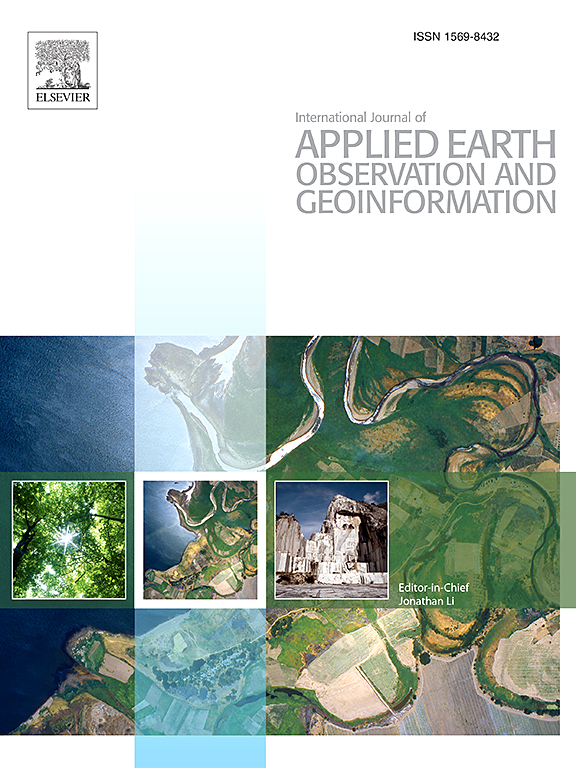Synergistic use of multi-sensor satellite data for mapping crop types and land cover dynamics from 2021 to 2023 in Northeast Thailand
IF 7.6
Q1 REMOTE SENSING
International journal of applied earth observation and geoinformation : ITC journal
Pub Date : 2025-06-14
DOI:10.1016/j.jag.2025.104673
引用次数: 0
Abstract
Accurate and timely information on the spatiotemporal distribution of crops is essential for sustainable agricultural practices and ensuring food security. The significant challenges persist in accurately classifying crop types in highly fragmented cropland regions characterized by small field sizes, complex landscapes, and highly frequent cloud cover. This study presents a novel classification workflow designed to generate archaic/historic and reliable land cover (LC) maps from integrating time series data from multiple EO sources—Sentinel-1, Sentinel-2, and the Highly Scalable Temporal Adaptive Reflectance Fusion Model (HISTARFM)—with the Random Forest (RF) classifier and cloud computing technology. To the evaluate the effectiveness of this approach, Northeast (NE) Thailand was selected as a case study region, focusing on the classification of 14 crop types between 2021 and 2023. Different combinations of EO datasets and a RF classifier were evaluated using a substantial dataset of 13,453 reference points. The crop type/LC transitions from 2021 to 2023 were then analysed and a temporal transfer model was employed to map historical crop fields. The combined all EO datasets in this work achieved high overall accuracy and F1 scores (>85 %) with the high spatial consistency of crop fields when compared to the use of combined both datasets. Results demonstrated the high potential and excellent efficiency of the RF, utilising an extensive reference dataset and the continuous temporal monthly information of gap-filled data. The most dominant crops were rice, followed by cassava, sugarcane and rubber trees throughout the three study years. The transfer learning RF model proved effective in mapping historical crop types and LC even when ground data was limited. Transitions of 7,287 km2 (∼5%) appeared from 2021 to 2022, with major crop decreases in rice and sugarcane. From 2022 to 2023, cropland changes totaled 8,466 km2 (∼6%), primarily as reductions in sugarcane and rubber trees. Our findings highlight the effectiveness of integrating multiple EO datasets in this study for mapping crop types across large areas and confirm the benefit of using monthly temporal data to obtain historic LC maps, providing valuable insights for a large range of stakeholders.
协同使用多传感器卫星数据绘制2021 - 2023年泰国东北部作物类型和土地覆盖动态
准确和及时的作物时空分布信息对于可持续农业实践和确保粮食安全至关重要。在耕地面积小、景观复杂、云层频繁的高度分散的农田地区,对作物类型进行准确分类仍然存在重大挑战。本研究提出了一种新的分类工作流程,旨在通过集成来自多个EO源的时间序列数据(sentinel -1、Sentinel-2和高度可扩展的时间自适应反射融合模型(histfm))以及随机森林(RF)分类器和云计算技术,生成古老/历史和可靠的土地覆盖(LC)地图。为了评估该方法的有效性,选择了泰国东北部(NE)作为案例研究区域,重点研究了2021年至2023年间14种作物类型的分类。使用13,453个参考点的大量数据集对EO数据集和RF分类器的不同组合进行了评估。然后分析了2021 - 2023年作物类型/LC的变化,并采用时间转移模型绘制了历史作物田图。与使用两种数据集组合相比,本工作中所有EO数据集的综合精度和F1分数(> 85%)都很高,农田的空间一致性也很高。结果表明,利用广泛的参考数据集和空白填充数据的连续时间月度信息,RF具有很高的潜力和出色的效率。在三年的研究中,最主要的作物是水稻,其次是木薯、甘蔗和橡胶树。即使地面数据有限,迁移学习RF模型在绘制历史作物类型和LC时也证明是有效的。从2021年到2022年,出现了7287平方公里(约5%)的变化,主要作物为水稻和甘蔗。从2022年到2023年,耕地变化总计8,466平方公里(约6%),主要是甘蔗和橡胶树的减少。我们的研究结果强调了在本研究中整合多个EO数据集绘制大面积作物类型地图的有效性,并证实了使用月度时间数据获取历史LC地图的好处,为大范围的利益相关者提供了有价值的见解。
本文章由计算机程序翻译,如有差异,请以英文原文为准。
求助全文
约1分钟内获得全文
求助全文
来源期刊

International journal of applied earth observation and geoinformation : ITC journal
Global and Planetary Change, Management, Monitoring, Policy and Law, Earth-Surface Processes, Computers in Earth Sciences
CiteScore
12.00
自引率
0.00%
发文量
0
审稿时长
77 days
期刊介绍:
The International Journal of Applied Earth Observation and Geoinformation publishes original papers that utilize earth observation data for natural resource and environmental inventory and management. These data primarily originate from remote sensing platforms, including satellites and aircraft, supplemented by surface and subsurface measurements. Addressing natural resources such as forests, agricultural land, soils, and water, as well as environmental concerns like biodiversity, land degradation, and hazards, the journal explores conceptual and data-driven approaches. It covers geoinformation themes like capturing, databasing, visualization, interpretation, data quality, and spatial uncertainty.
 求助内容:
求助内容: 应助结果提醒方式:
应助结果提醒方式:


